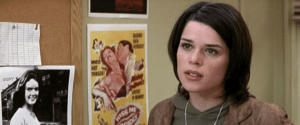
Reader's Choice
Reviews commissioned and selected by Patrons
Scream 3
3 Stars- Director
- Wes Craven
- Cast
- David Arquette, Neve Campbell, Courteney Cox, Patrick Dempsey, Scott Foley, Lance Henriksen, Matt Keeslar, Jenny McCarthy, Emily Mortimer, Parker Posey, Deon Richmond, Patrick Warburton
- Rated
- R
- Runtime
- 116 min.
- Release Date
- 02/04/2000
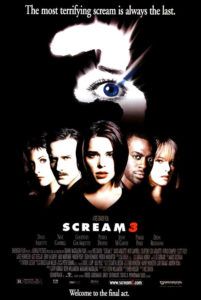
Given how much Scream (1996) and its 1997 sequel comment on the horror genre, it was inevitable that a future installment would take place in Hollywood. Scream 3 unfolds against the production of a franchise-within-a-franchise sequel called Stab 3: Return to Woodsboro, creating a mirroring effect between the two. Arguably the most star-studded sequel as well, and the most purely comic, the movie nevertheless sidesteps Neve Campbell’s survivor Sidney Prescott, whose presence feels like an afterthought next to series players Courteney Cox and David Arquette. Released in 2000, the movie would proclaim itself the end of a trilogy. And besides its remarks on trilogies and the usual commentary on the horror clichés its characters are doomed to fulfill, it’s also a film about Hollywood’s dark side, specifically—and ironically given its studio—the ingénues whom producers exploit. Although its script isn’t as tightly wound or chilling as its predecessors, the film has more to say, which, in the wake of #MeToo and Harvey Weinstein’s conviction for several counts of rape, makes it seem ahead of its time. But in retrospect, its thematic conclusion to the so-called trilogy feels ungainly, and horror fans may come away underserviced. Regardless, Scream 3 remains another entertaining chapter in the franchise.
The opener follows Cotton Weary (Liev Schreiber), who was wrongly convicted and since cleared of the rape and murder of Sidney Prescott’s mother, Maureen (Lynn McRee). Cotton has used his media attention to build a nationally syndicated Maury Povich-style talk show, 100% Cotton. While caught in L.A. traffic, he receives a call from a sultry-voiced fan who turns out to be the killer, and this time around, the culprit uses a doohickey that can make them sound like anyone. The killer sneaks into Cotton’s home, using the voice-altering device to taunt his girlfriend, Christine (Kelly Rutherford), who thinks it’s part of Cotton’s usual role-playing routine (“You know I don’t like your Stab games,” she remarks). Cotton races home to find Christine on the defensive, believing Cotton has taken his bedroom antics too far. But then, all at once, the killer slays Christine and stabs Cotton, then places a photograph of Maureen on Cotton’s chest before he dies. Thus, with Maureen’s photo, Scream 3 establishes a theme of digging up the past and reframing what the viewer and characters know about why the Ghostface killings started in the first place.
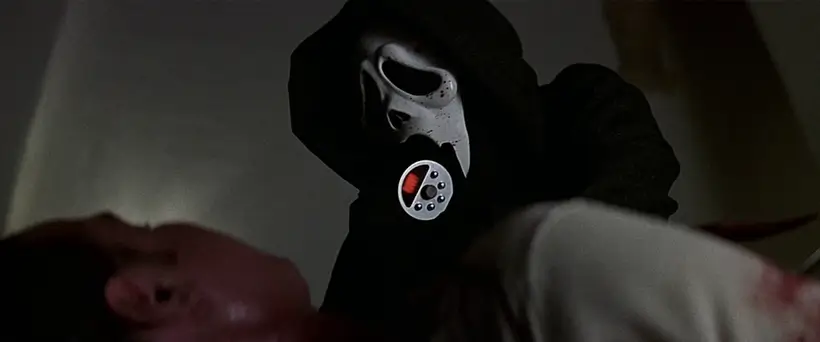 “Trilogies are all about going back to the beginning and discovering something that wasn’t true from the get-go,” remarks resident movie geek Randy (Jamie Kennedy), who makes a final appearance from beyond the grave in a clumsy scene involving a videotape shared by his sister (Heather Matarazzo). The tape—watched by Sidney, entertainment reporter Gale Weathers (Cox, behind some atrocious bangs), and former cop Dewey Riley (Arquette)—defines the rules when closing out a trilogy. Randy declares that Part 3s will bring the story full circle, back to the beginning: “Whatever you think you know about the past, forget it.” Conveniently, Randy never admits that past Part 3s have historically been underwhelming conclusions to their predecessors and rarely end franchises on a high note, perhaps to avoid setting up the audience for disappointment. Today, looking at Scream 3 against the next few sequels, the trilogy commentary feels narrow, if not optimistic that Ghostface won’t return for Scream 4 (which hit theaters in 2011). However, the scene with Randy establishes how the movie will add another layer to the original’s mythology, even if the screen story seems to engage in retroactive continuity—and not for the last time in this franchise.
“Trilogies are all about going back to the beginning and discovering something that wasn’t true from the get-go,” remarks resident movie geek Randy (Jamie Kennedy), who makes a final appearance from beyond the grave in a clumsy scene involving a videotape shared by his sister (Heather Matarazzo). The tape—watched by Sidney, entertainment reporter Gale Weathers (Cox, behind some atrocious bangs), and former cop Dewey Riley (Arquette)—defines the rules when closing out a trilogy. Randy declares that Part 3s will bring the story full circle, back to the beginning: “Whatever you think you know about the past, forget it.” Conveniently, Randy never admits that past Part 3s have historically been underwhelming conclusions to their predecessors and rarely end franchises on a high note, perhaps to avoid setting up the audience for disappointment. Today, looking at Scream 3 against the next few sequels, the trilogy commentary feels narrow, if not optimistic that Ghostface won’t return for Scream 4 (which hit theaters in 2011). However, the scene with Randy establishes how the movie will add another layer to the original’s mythology, even if the screen story seems to engage in retroactive continuity—and not for the last time in this franchise.
Even while Scream 2 was still in production, Craven had been intrigued by the idea of a single director completing the trilogy. However, Kevin Williamson, screenwriter of the first two films, had an option in his Miramax contract that he could direct Scream 3, whereas Craven had a three-picture deal that included the first two Scream movies, plus a third non-horror film—something he had long yearned to make. Regardless, Craven remarked after Scream 2, “It would be good to have the original director do all three. It’s certainly a fascinating thing to think of, as a filmmaker, to do a trilogy. There are very few filmmakers that have actually done it.” While notions of a trilogy percolated, Craven and Williamson had other projects to complete. Craven finally made his prestige drama, starring Meryl Streep no less, with 1999’s Music of the Heart. And Williamson spent the years after Scream 2 continuing to make horror movies at Dimension, including Halloween H20: 20 Years Later and The Faculty in 1998, along with launching his teen soap opera, Dawson’s Creek (1998-2003). But it was Williamson’s choice to direct his script of Teaching Mrs. Tingle in 1999 at Dimension that prevented him from contributing more than a 30-page outline to Scream 3—a treatment that involved the production of Stab 3 shooting in Woodsboro, ending the trilogy where it began.
Ultimately, the production went ahead without Williamson, and Craven, who wanted the trilogy to end in Hollywood, didn’t use most of Williamson’s ideas. In a flourish that would recall how the director satirized Hollywood with his Freddy Kruger series in Wes Craven’s New Nightmare (1994), Craven fought to explore Scream’s self-referentiality to its fullest, telling a story where the series characters interact with their onscreen counterparts from Stab 3. Working closely with Craven, screenwriter Ehren Kruger, whose surname amused the director, used Williamson’s treatment as a springboard while excising a major story thread. Williamson’s original idea involved a cult of serial killer worshippers who follow Ghostface’s example. But Miramax expressed concern about the possibility of actual copycats given the recent Columbine High School shootings in 1999. The studio wanted to avoid getting roped into the media debate—an argument going back to Plato and Aristotle, but more contemporaneously in response to Scream and Scream 2—about whether entertainment influences viewers. Fearing negative press, Miramax resolved to ditch the cult storyline (Williamson would apply the idea to his TV show The Following), downplay the violence, and instead play up the Hollywood satire.
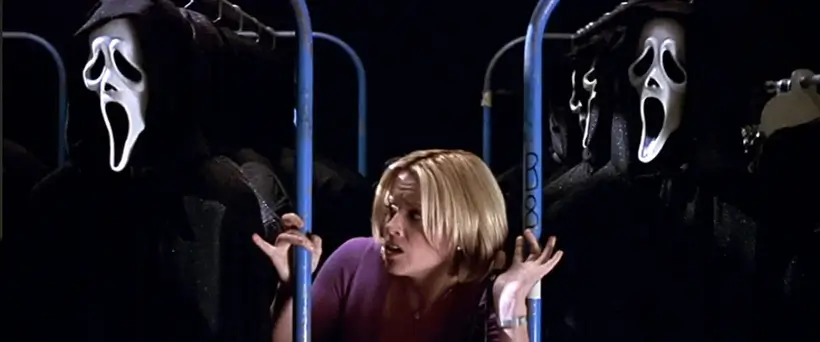 In a strain of art imitating life imitating art—a recurrent Scream motif—the killer selects their victims based on the order in which the characters in the Stab 3 script die. Since it’s a closed set and the screenplay remains top secret, the whodunit suspects include everyone close to the rocky production: the leading lady (Emily Mortimer), starring as Sidney; the cast’s resident diva (Parker Posey), playing Gale; an actress (Jenny McCarthy) hired for her looks; the Randy alternate (Deon Richmond); the resident Dewey (Matt Keeslar); the frustrated young director, Roman Bridger (Scott Foley); and the sleazy Sunshine Studio mogul John Milton (Lance Henriksen). On the periphery, Patrick Dempsey and his hair play Det. Mark Kincaid, who investigates the murders alongside Gale and Dewey. Meanwhile, Sidney’s location—on a secluded property with a dog, out of the public eye, and working as an anonymous crisis helpline operator—remains a secret. Though, she’s haunted by memories of her mother, which, along with the photos of Maureen left by the killer, instill the notion that maybe, just maybe, the killer might be connected to her mother’s death. Still, the de-emphasis on Sidney allows the production to boost Cox and Arquette’s roles. Fitting, since their offscreen marriage in 1999 became the stuff of tabloid and entertainment news fodder, driving up their popularity. Anyhow, after a few clunky red herrings—with Kincaid and Milton among them—Sidney shows up to unmask the killer and reveal how he has orchestrated (or “directed”) the Ghostface killings since the beginning.
In a strain of art imitating life imitating art—a recurrent Scream motif—the killer selects their victims based on the order in which the characters in the Stab 3 script die. Since it’s a closed set and the screenplay remains top secret, the whodunit suspects include everyone close to the rocky production: the leading lady (Emily Mortimer), starring as Sidney; the cast’s resident diva (Parker Posey), playing Gale; an actress (Jenny McCarthy) hired for her looks; the Randy alternate (Deon Richmond); the resident Dewey (Matt Keeslar); the frustrated young director, Roman Bridger (Scott Foley); and the sleazy Sunshine Studio mogul John Milton (Lance Henriksen). On the periphery, Patrick Dempsey and his hair play Det. Mark Kincaid, who investigates the murders alongside Gale and Dewey. Meanwhile, Sidney’s location—on a secluded property with a dog, out of the public eye, and working as an anonymous crisis helpline operator—remains a secret. Though, she’s haunted by memories of her mother, which, along with the photos of Maureen left by the killer, instill the notion that maybe, just maybe, the killer might be connected to her mother’s death. Still, the de-emphasis on Sidney allows the production to boost Cox and Arquette’s roles. Fitting, since their offscreen marriage in 1999 became the stuff of tabloid and entertainment news fodder, driving up their popularity. Anyhow, after a few clunky red herrings—with Kincaid and Milton among them—Sidney shows up to unmask the killer and reveal how he has orchestrated (or “directed”) the Ghostface killings since the beginning.
Miramax gave Craven a budget of $40 million, significantly more than Scream 2, to complete his trilogy. And even today, it’s rare to find a filmmaker who completed each entry in a trilogy, save for Steven Spielberg, Francis Ford Coppola, Christopher Nolan, Peter Jackson, and a few others—and it’s rarer still in horror. The production faced challenges in the form of set leaks, which had become typical for every subsequent Scream sequel after the original. And the film’s in-jokes about closed sets, various versions of the script, and the threat of online leaks echoed the troubles faced by Scream 3’s production. Craven once again worked with his Scream 2 cinematographer Peter Deming and composer Marco Baltrami, and all of them seem to be replicating the aesthetic of the original—albeit without one standout sequence given the downplaying of violence. The exception is when Sidney, home alone, finds herself haunted by a specter resembling her mother. A wraithlike apparition appears outside and approaches Sidney’s window, only to transform into an attacking Ghostface before Sidney abruptly awakens from her dream. Craven explores what by this time had become a well-worn theme in his films, raising questions about the line between reality and altered states (dreams, media, etc.) in one of the Scream franchise’s only full-on dream sequences.
Following the law of diminishing returns, Scream 3 made about $10 million less than previous entries and garnered the franchise’s worst reviews yet, with many critics remarking that the series’ in-jokes had grown tired. To be sure, the genre satire doesn’t have the same edge as the earlier movies—perhaps because it wasn’t paired with skewering violence—and the film’s remarks on Hollywood tend to feel softened next to the prevailing cameos. Jason Mewes and Kevin Smith appear as their Smith-verse counterparts Jay and Silent Bob, owing to their servitude at Miramax. B-movie legend Roger Corman appears as a studio executive. Carrie Fisher shows up to make a crack at herself about sleeping with George Lucas for the role of Princess Leia. And yet, none of these cameos have anything to say about the state of horror movies circa 2000. There’s no wit behind them, just throwaway humor without a real subject beyond some basic visual gags, which, of course, are also a Scream franchise staple. And while Parker Posey could be accused of over-delivering in every scene to almost distracting effect, it’s the kind of welcome distraction that makes her presence an unpredictable joy. Even when she isn’t the focal point of a scene, watch her; every gesture and facial expression becomes a comedic detail that rewards a rewatch. Returning to the movie, it’s easy to lose track of what’s happening in the plot if only because Posey’s comic performance sucks our attention like a vacuum.
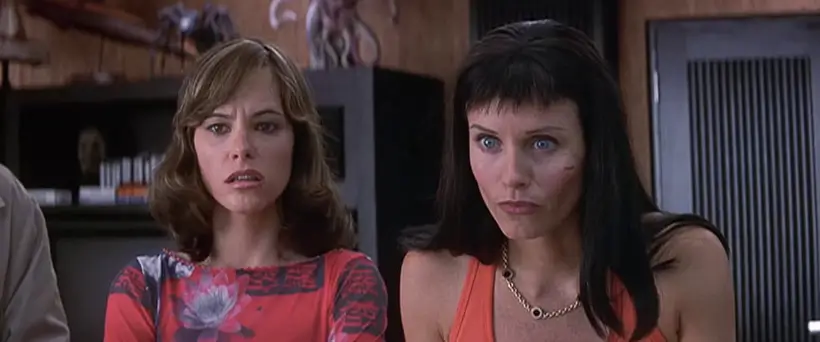 Critics ignored the theme in 2000, but Scream 3 also jabs at Hollywood hedonism, its exploitation of young wannabe actresses, and the men who perpetuate the system. The story reveals that Sidney’s mother, Maureen, spent two years in Hollywood at Sunrise Studios under an assumed name, but she was victimized during one of Milton’s out-of-control parties in the 1970s, where things went “too far.” Milton adds, “Nothing happened to her that she didn’t invite,” in a disturbing touch of victim-blaming. The incident prompted her to quit Hollywood, return to Woodsboro, and start a family. But Maureen’s time in Hollywood produced a child, Roman, who resented that she abandoned him, and so he took revenge with his elaborate murder scheme that gave birth to Ghostface in the original Scream. Given that the film’s director character is named Roman and has serious issues (a reference to Roman Polanski, no doubt), and its ruthless studio exec character makes no apologies for using up women at drug-addled Hollywood parties, it’s a historical irony that Kruger included these themes while the Weinsteins ran Miramax. Today, it seems almost impossible that Kruger would include Milton’s line, “Hollywood’s full of criminals whose careers are flourishing,” without Harvey Weinstein’s reputation in mind—and even more impossible that the line passed Weinstein’s oversight.
Critics ignored the theme in 2000, but Scream 3 also jabs at Hollywood hedonism, its exploitation of young wannabe actresses, and the men who perpetuate the system. The story reveals that Sidney’s mother, Maureen, spent two years in Hollywood at Sunrise Studios under an assumed name, but she was victimized during one of Milton’s out-of-control parties in the 1970s, where things went “too far.” Milton adds, “Nothing happened to her that she didn’t invite,” in a disturbing touch of victim-blaming. The incident prompted her to quit Hollywood, return to Woodsboro, and start a family. But Maureen’s time in Hollywood produced a child, Roman, who resented that she abandoned him, and so he took revenge with his elaborate murder scheme that gave birth to Ghostface in the original Scream. Given that the film’s director character is named Roman and has serious issues (a reference to Roman Polanski, no doubt), and its ruthless studio exec character makes no apologies for using up women at drug-addled Hollywood parties, it’s a historical irony that Kruger included these themes while the Weinsteins ran Miramax. Today, it seems almost impossible that Kruger would include Milton’s line, “Hollywood’s full of criminals whose careers are flourishing,” without Harvey Weinstein’s reputation in mind—and even more impossible that the line passed Weinstein’s oversight.
Although the first two sequels grow increasingly tame concerning violence compared to the 1996 original—after all, it boasted disembowelment in the opening sequence—Scream 3 contains a thematically darker undercurrent given its remarks on Hollywood. But by the end of the trilogy, there is no question: the Scream franchise to this point is less about slasher horror than punchy dialogue and whodunit twists, and the third movie aligns more with Robert Altman’s The Player (1992) than a typical slasher. All of the Scream titles have something to say about the movies, how they work, why we love watching them, and the collateral damage in their wake—be it those disturbed individuals who remain susceptible to the movies’ influence or those filmmakers who use the industry as hunting grounds. Scream 3 is more direct than most. As a result, the film has grown and deepened since its release in 2000. And even though Posey’s enduringly funny goofball performance and the sequel’s unyielding attempts at a lighter tone might deflate its bleak Hollywood commentary and pure slasher scares, Scream 3 proves entertaining enough to sustain goodwill toward the franchise.
(Note: This review was suggested and commissioned on Patreon and published on February 23, 2023.)
Bibliography:
Maroney, Padriac. It All Began with a Scream. BearManor Media, 2021.
Robb, Brian J. Screams and Nightmares: The Films of Wes Craven. Polaris Publishing, Inc., 2022.
Wooley, John. Wes Craven: The Man and His Nightmares. John Wiley and Sons, Inc., 2011.






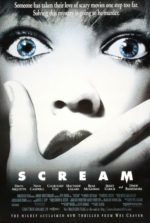 Scream
Scream 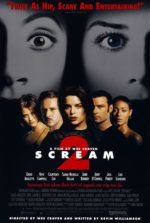 Scream 2
Scream 2 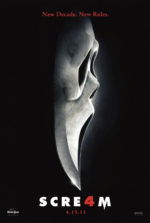 Scream 4
Scream 4